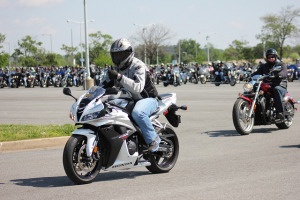 So you just purchased a new motorcycle. It’s time to hit the road, right? Not quite. Before you jump onto your new wheels, be sure to have the appropriate gear.
So you just purchased a new motorcycle. It’s time to hit the road, right? Not quite. Before you jump onto your new wheels, be sure to have the appropriate gear.
Most can agree on the importance of a motorcycle helmet when riding. However, there is other motorcycle gear that can potentially save your life. When you are riding a motorcycle, your body is more vulnerable to injury if an accident were to occur. The most common motorcycle injuries are scrapes and cuts, or “road rash.” In the case of motorcycle riding, road rash happens when your body hits the pavement. Road rash often comes with more severe injuries such as broken bones and torn ligaments.
Below is a list of items that you should consider owning:
Helmet
- A full face-helmet is an investment. In motorcycle crashes where helmets are damaged, 45% of the damage occurs in areas that are not covered by open-face type helmets.
- It keeps bugs out of your mouth and the wind out of yours eyes.
- Make sure that the shield on your helmet can withstand impacts and that they are free of dents/scratches.
- Tinted shields can also act as sunglasses for riding in the morning and afternoon
- Lastly, make sure you get the appropriate type of helmet for the riding you want to do. You’ll know if it’s the right one if it has a DOT (Department of Transportation) sticker somewhere on it. The DOT only approves helmets that can withstand forces that could injure your head and brain.
Jacket
- Your motorcycle jacket acts as body armor. It absorbs the impact of a collision and protects against road rash.
- An effective motorcycle jacket will come with a CE safety rating. Armor should be placed in the shoulders, back, and elbows.
- Jackets come in either leather or textile. Textile is more affordable, but leather tends to last longer. Seams are doubled up multiple times to prevent bursting from abrasion.
- You want a jacket that is snug but still allows you to move your arms. If you have to hunch over when riding your bike, be sure to find a jacket that allows you to do so.
Gloves
- Make sure that the gloves you choose have armor not only on the knuckles, but also on the palms—this is the area that most commonly hits the pavement first.
- The gloves you choose should be abrasion resistant with quality stitching.
- Gloves should cover your entire hand with no exposed skin. They should also have an adjustable strap around the wrist so they remain secure.
- Be sure that your jacket extends long enough to cover your wrist (or where the glove ends). You shouldn’t have any skin showing on your arm.
Boots
- Motorcycle boots should extend beyond the ankle and should lace or buckle tightly.
- There are also boots that contain metal plates through the soles, heals, and toes. These help keep your foot in place.
- You want boots that have weather resistant soles and good ankle support.
Although it might seem that motorcycle gear wouldn’t make a huge difference in when involved in a collision, statistics show that 75% of motorcycle crashes happen at speeds over 35mph. The appropriate gear in collisions at these speeds makes the difference between a few scrapes and a hospital visit.
Sources: How Stuff Works, RideApart, DMV.org
Photo Credit: Elvert Barnes via Creative Commons
